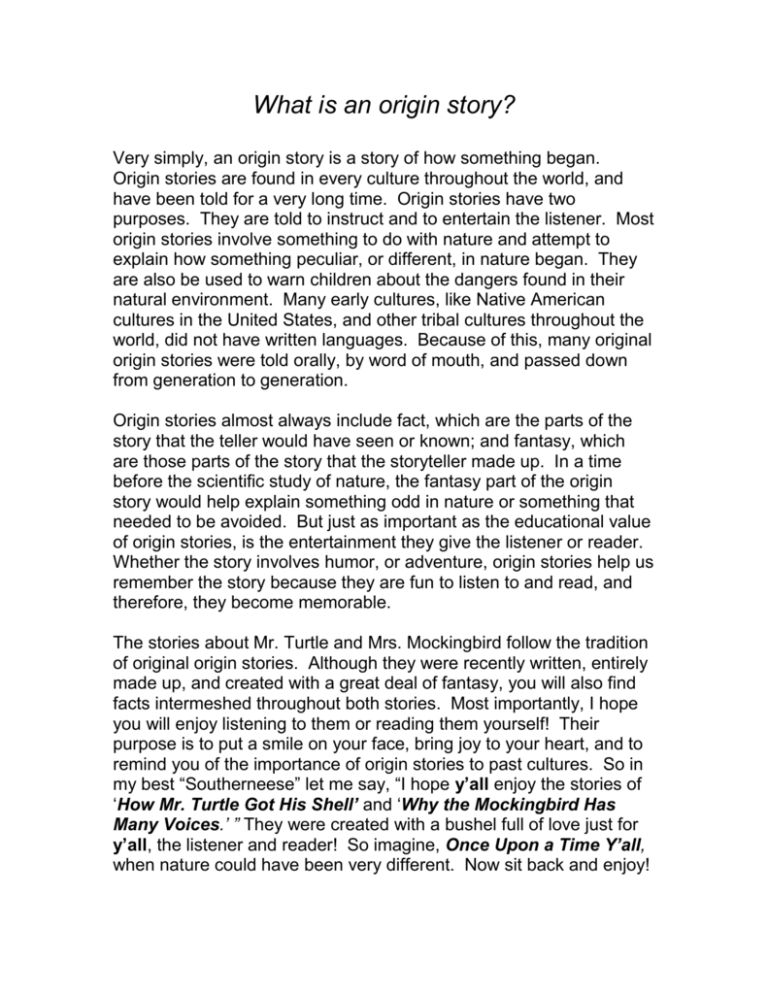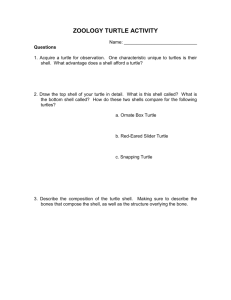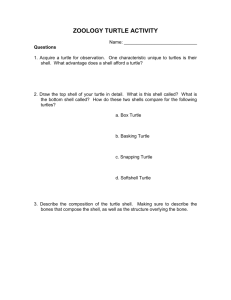What is an origin story
advertisement

What is an origin story? Very simply, an origin story is a story of how something began. Origin stories are found in every culture throughout the world, and have been told for a very long time. Origin stories have two purposes. They are told to instruct and to entertain the listener. Most origin stories involve something to do with nature and attempt to explain how something peculiar, or different, in nature began. They are also be used to warn children about the dangers found in their natural environment. Many early cultures, like Native American cultures in the United States, and other tribal cultures throughout the world, did not have written languages. Because of this, many original origin stories were told orally, by word of mouth, and passed down from generation to generation. Origin stories almost always include fact, which are the parts of the story that the teller would have seen or known; and fantasy, which are those parts of the story that the storyteller made up. In a time before the scientific study of nature, the fantasy part of the origin story would help explain something odd in nature or something that needed to be avoided. But just as important as the educational value of origin stories, is the entertainment they give the listener or reader. Whether the story involves humor, or adventure, origin stories help us remember the story because they are fun to listen to and read, and therefore, they become memorable. The stories about Mr. Turtle and Mrs. Mockingbird follow the tradition of original origin stories. Although they were recently written, entirely made up, and created with a great deal of fantasy, you will also find facts intermeshed throughout both stories. Most importantly, I hope you will enjoy listening to them or reading them yourself! Their purpose is to put a smile on your face, bring joy to your heart, and to remind you of the importance of origin stories to past cultures. So in my best “Southerneese” let me say, “I hope y’all enjoy the stories of ‘How Mr. Turtle Got His Shell’ and ‘Why the Mockingbird Has Many Voices.’ ” They were created with a bushel full of love just for y’all, the listener and reader! So imagine, Once Upon a Time Y’all, when nature could have been very different. Now sit back and enjoy! Activities to Help You Understand Origin Stories 1. Why is the term “origin” appropriate for the types of stories in this book? The story attempts to explain the origin of a particular feature of each animal – i.e.… turtle’s shell & mockingbird’s varied songs 2. What purpose would an origin story have in a past culture? An origin story would help explain something that a society could not explain through observation – it could also be used to educate children to potential dangers, and to entertain 3. Why is it logical that origin stories were created? People want to be able to explain things they don’t understand - They can also confirm cultural beliefs about certain animals (like snakes are evil) – Origin stories confirm what people observe and fill in the answers to features or events that can’t be explained through observation 4. List some components that would be common to all origin stories. They instruct and entertain – they include fact and fantasy – they usually deal with nature 5. Why were so many origin stories spoken, but not written? Many early tribal cultures did not have a written language, but instead strong oral traditions where children were educated through stories told by their elders 6. Look individually at the “Turtle” story and the “Mockingbird” story. Create a chart for each and list what is fantasy and what is fact in each story. Refer to the chart 7. Looking at both the “Turtle” and “Mockingbird” stories, were they meant to explain something odd in nature or would they have been used to teach the dangers found in nature? Explain the specific purpose of each story. Refer to the chart 8. Again look at both stories. List the main characters of each story. What lesson/lessons did each character learn as they progressed through the story? What lessons, from the stories, could apply to your life today? Refer to the chart 9. What did you find enjoyable or entertaining about each story? How did the voice or tone of the stories affect your enjoyment of them? Please explain in four or five well developed sentences. – answers will vary ------------------------------------------------------------------------------------------------------- Write Your Own Origin Story 1. Think about something in nature you find curious, interesting, or even dangerous. List this animal, plant, or place. 2. Now, think about observing what you’ve listed. What could you learn about your animal, plant, or place just by watching or listening to it? List every fact you could observe. 3. What’s odd or dangerous about the animal, plant, or place you’ve selected? What does it do that can’t be explained through simple observation. For example, you know a snake slithers on its belly. You observe that. But, your observation doesn’t explain why a snake first began to slither on its belly. 4. Brainstorm, using your imagination. What fantasy could you imagine that might explain why the animal, plant, or place you chose behaves in a certain way, or has a certain ability, that makes it stand out. List as many explanations as possible, letting your imagination go wild! 5. Finally, put all this together and write your own origin story. Remember though, a good origin story entertains as well as explains! How Mr. Turtle Got His Shell Fantasy Fact Turtles are wise creatures Turtles have shells Turtles were once one of the fastest creatures in the forest Like frogs, turtles can live on land and water, and can eat from both places First turtles didn’t have shells Many animals in the forest have natural protection from their enemies Turtles can talk The Turtle requested a conference with God Turtles can swim very fast Turtles are aware of their blessings The turtle uses his shell for protection God and Turtle talked, met, and that meeting led to the Turtle getting his shell This story is entertaining and can bring joy to the listener. This story can also confirm the society’s beliefs about God & his love for all creatures in their society. Purpose This story helps explain why a turtle has a shell, something that is unusual, but easily observed in nature. Why the Mockingbird Has Many Voices Fantasy Mockingbirds originally couldn’t mock other bird songs All animals in the forest can talk to each other Wren came to Mockingbird to protect her eggs from the Snake Wren and Mockingbird created a plan to fool Snake Fact Mockingbirds can mock the call of other birds There are many different birds in the forest with many different calls Snakes do eat bird eggs Some animals hunt other animals as part of their survival Mockingbird fooled Snake & Snake became lost in the forest Other birds came to Mockingbird for protection Mockingbird’s superior brain allowed her to learn other songs & fool the snake Mockingbird does not have her own call & can only sing other bird’s calls Purpose This story is entertaining and can bring joy to the listener. This story explains how the mockingbird got her name and why she can mock the call of different birds. This story could have been told to show the interdependence of animals in nature.









